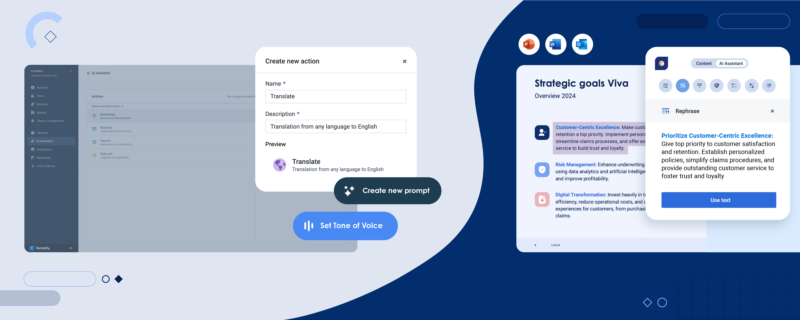In an era where companies can track almost all their revenue sources digitally, it’s no surprise that tracking abilities have now expanded to include documents. But what does document tracking include? And why does it offer such important insights for sales teams in particular?
Before we delve into the importance of document tracking, it’s necessary to know what document tracking actually refers to in order to understand how significant it is.
The definition of document tracking is: "A system that automates the process of accessing, searching and editing documents that enables you to control who views and edits a document." Practically, this transforms a document from a one-dimensional, static tool and makes it a collaborative and insightful tool that can provide vital insights for your organization.
The importance of document tracking stems from the document analytics that it provides – gone are the days of sending documents into the abyss and hoping for the best. Now, it’s possible to see exactly what happens to them after pressing send. And in an impressive amount of detail! From this, you can see what interaction occurs at what stages, whether it’s a specific slide of a sales presentation that’s lingered on or a lengthy contract that is shared between various people who open it at different times.
Knowing more about what’s happening within a document means organizations can optimize for a document’s success. No communication is one-way, and focusing on just the initial message hinders how effective your communication can be. But that’s been the way it has had to be. In the absence of tracking capabilities, all documents are, to a greater or lesser extent, shouting into the void and hoping for success. While you may be able to tell where some perform better than others, with the absence of knowledge about how and why it’s difficult to capitalize on this success.
By understanding exactly where your documents succeed and fall short, you can implement changes that lead to more success. Just as you’d change your routine if a sleep tracking app showed you that certain patterns lead to less sleep, document tracking provides you with insights that can be changed. Adapting the document creation process as a result of these aids success, furthers engagement, and, ultimately, improves your business communication.
The benefits of document tracking for sales teams
Although document tracking has benefits across all departments in an organization, the benefits are most impressive for sales teams, and this is an area that can hugely benefit from this kind of sales enablement.
Much of successful sales rely on timing and the ability to see what a prospect's needs are. The insights offered from the data in document tracking allow salespeople to more successfully utilize these points. For example, where a prospect has recently re-opened a document after a while, it suggests a good time to follow up with them, or if they’ve passed it to a different member of their team, salespeople should focus on researching the value propositions for that particular job role.
Sales is a highly competitive industry, and it will continue to be that way. As with all competitive industries, analytics offers an advantage over competitors, and for sales teams, this is vital for successful sales. When your sales team utilize document tracking tools to fit their particular needs, the added value and insights will enable them to perform their job to a better ability. The customer insights provided by tracking gives them countless opportunities to hone their pitch and techniques to match customer needs.

Features of document tracking systems
That might all sound too good to be true, but also lead to the question of how it works? Well, there are a variety of tools that provide document tracking systems, and each type of software works in a slightly different manner, meaning there's no definitive type to use. To provide some clarity, here are the main beneficial features of every general type of document tracking system and why each tool is so useful.
1. Engagement details
The first document tracking feature is probably the most well-known and understood one: engagement details.
Through tracking links and seeing what happens to a document once you’ve sent it, the engagement provides vital insights into your document’s journey. Although the exact specificities vary depending on the solution, some of the elements which document tracking solutions offer include:
- Who has opened a document.
- When they opened it.
- How long the document has been open.
- Which sections of the document have most interactions.
By understanding these engagement details, organizations can understand a lot more about how to optimize their documents. For example, if everyone who opens a presentation focuses on a certain slide, it probably contains vital information that should be capitalized. Similarly, if a lengthy written document is closed at the same stage by several people, then maybe the wording of the document merits further work to make it more accessible. Where documents aren’t opened, it’s time to consider the title, the time of sending, or even whether it has gone to the best person to be interested in the content.
Alongside providing insights into the document itself, engagement details also give insights into the person who is interacting with it. Particularly with sales-related content, it may be that the prospect who is viewing the content is focusing on a particular section or sharing this with other members. This provides information about the importance of that section or the difficulties within it and allows you to give further relevant information if necessary. For example, if the area focused on is related to a specific product feature, it might then be wise to send further product information to the recipient to help clarify questions they may have. By understanding the areas that recipients are frequently viewing, you can tailor the communication and ensure you are providing the information that they require.

2. Collaboration features
Secondly, document tracking software offers a clear benefit through the collaboration features which it provides.
Again, this feature varies depending on the type of system used, but almost all offer at least some form of collaboration – to put it bluntly, this means that many different people can easily work on the same document. In the complex landscape of today’s document-heavy world, it’s easy for versions of documents to be confused: when documents are exchanged as email attachments and saved to employee's desktops then problems are rife as the version number is not always clear. This difficulty worsens when they are documents that require input from multiple individuals.
Document tracking removes these difficulties, providing a solution that means multiple people can work on the same document, which is accessed from a central location. Need input from a colleague on a section of the content? They can find it in the same place you can, and their changes are reflected in the document immediately. There are no longer difficulties with checking you’re using the latest version, as the only version is always the correct version. The benefits from this are boundless, from saving time to ensuring accuracy, and most importantly, providing a better service to the recipient who is provided with just one accurate version.
3. Integrations
Finally, integrations are a powerful document tracking tool that improves workflows and makes a more simple document creation process.
The document ecosystem has come a long way from the days where it was a case of just opening a document creation application and working from there. These days, there are countless systems and possibilities to integrate other applications used into your document ecosystem to speed up the creation process and streamline workflows. It’s also practical as part of document tracking to ensure documents integrate with the relevant other systems, such as CRM systems or DAM systems. Productivity increases as it is quick and efficient to include the correct and needed elements into the documents created.
Although the benefits of this may not appear as obvious as being able to understand how prospects interact with your data, the time saved is hugely beneficial, especially in a fast-paced work environment. It frees up resources to prioritize on meeting client needs and ensuring documents are tailored to them.
By ensuring that all the information in a document is automatically correct, from client details to legal disclaimers and branding, the document itself has a more professional and correct finish. Consequently, it’s more likely that it will be well-received, and the organization viewed more favorably.
Overall, it’s clear that document tracking is a vital tool for improving sales performance. It enables employees to craft better documents, track how they are performing with the ability to edit them as necessary, and integrate with all the systems that are needed to streamline and speed up the document creation process while not hindering the professionality of the final product.




